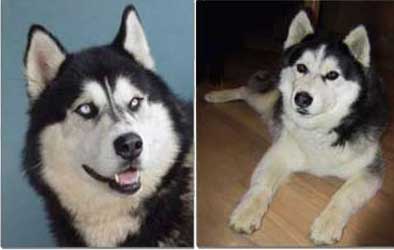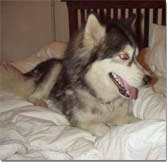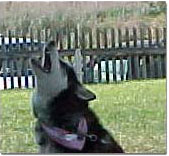Siberian Husky |
 |
Owner LevelFor experienced involved dog ownersAverage Life Span10-14 yearsAverage WeightMale are generally 45 to 60 pounds. Females are generally 35 to 50 poundsAverage HeightMales are generally 21 to 23 1/2 inches at the withers. Females are generally 20 to 22 inches at the withersColour And CoatCoat colour types ranges from: Pure white, grey, red, sable, agouti (guard hair is banded with black near the root and at the tip with a yellow or beige band at the centre of the hair), jet black/white.Grooming is mainly brushing bathing etc. If you don't like dog hair, don't get a Siberian Husky. This dog is equipped with excessive fur to survive sub-zero temperatures. The insulating downy undercoat sheds in early to late spring. They shed a little all year round. Siberians also have a variety of eye colours. Many are spellbinding with their beauty. Eye colours: Varied hues of coppery to brown chocolate brown, icy blue, or bi-colour, which is one brown and one blue eye.Typical Health ProblemsHip dysplasia is definitely seen in this breed but in a moderate frequency level. Eyes disorders are a seen in this breed and are all of a serious nature. The most common are: Hereditary or juvenile cataracts, corneal dystrophy, and progressive retinal atrophy, glaucoma. Each disorder occurs in a different portion of the eye, and can occur in any eye colour. These disorders can result in blindness and lead to other life threatening health problems. Treatments and corrective surgeries, if possible, are costly. Yearly eye exams are a must.History and Personality Originally bred by the nomadic peoples of the Chukchi Tribe, of Siberia. The Siberian Husky was developed to provide transportation over the vast frozen land. This tough, strong medium size dog was able to quickly cover long distances on very little food. They were bred to have a gentle nature and were an integral part of everyday family life. The relationship born of mutual need and nurtured by mutual respect existed between this dog and the Chukchi people. The Siberian lived in isolation for centuries before the outside world discovered it and bought it to other regions. The present day Siberian Husky has changed a lot since 1900, but within the current Siberian Husky breed the heart and drive of the beloved and much prized, Chukchi dog still lives. Originally bred by the nomadic peoples of the Chukchi Tribe, of Siberia. The Siberian Husky was developed to provide transportation over the vast frozen land. This tough, strong medium size dog was able to quickly cover long distances on very little food. They were bred to have a gentle nature and were an integral part of everyday family life. The relationship born of mutual need and nurtured by mutual respect existed between this dog and the Chukchi people. The Siberian lived in isolation for centuries before the outside world discovered it and bought it to other regions. The present day Siberian Husky has changed a lot since 1900, but within the current Siberian Husky breed the heart and drive of the beloved and much prized, Chukchi dog still lives.
Today's Siberian is a beautiful, captivating, eager, outgoing, animated canine companion.They have the ability to charm and hold captive the hearts of many. Their abilities in addition to companion animals are: Sledding, carting, running companion, agility, obedience. This breed has many charms, however they also have strong and difficult behaviours that require a special effort for successful ownership. |
Who should own this breed? This fun loving, affectionate, outgoing, breed requires an experienced, committed, stable owner that has educated themselves well on this breed's needs. Siberian owners should be aware of this dog's amazing natural abilities and desires. They should also know that those abilities and desires, if not channelled and use will become a problem. The Siberian Husky attracts a lot of people because of its beauty. They are also adorable puppies and win people's hearts in an instant. Many uneducated, puppy smitten owners soon find out this is not the breed for everyone. This is a fantastic, but very specialised breed that requires a special owner to be successful. This fun loving, affectionate, outgoing, breed requires an experienced, committed, stable owner that has educated themselves well on this breed's needs. Siberian owners should be aware of this dog's amazing natural abilities and desires. They should also know that those abilities and desires, if not channelled and use will become a problem. The Siberian Husky attracts a lot of people because of its beauty. They are also adorable puppies and win people's hearts in an instant. Many uneducated, puppy smitten owners soon find out this is not the breed for everyone. This is a fantastic, but very specialised breed that requires a special owner to be successful.
Siberian Huskies are high energy. Always look to a dog’s historical roots and modern jobs for insight. These dogs were originally bred to run in sub-zero temperatures for long distances and still do. Their endurance and desire to go is not the correct match for the average pet owner. But for many Siberian owners, this breed becomes a lifelong passion of the heart and they would own no other. |
|
Clinic
2 Airport Road, Cnr Cranborne Avenue,
Hatfield, Harare
Telephone: 0712 211 900 | (04) 576 356 / 7 | (04) 581 347
Opening hours:
Monday - Friday 0800 - 1630
Weekends & Public Holidays: 0800 - 1230
Re-Homing Kennels
Cranborne Avenue, Cnr Seke Road, Hatfield, Harare.
Telephone: 0718 368 602
Opening hours:
Monday - Friday 0730 - 1630
Weekends & Public Holidays: 0730 - 1500

 Siberian Huskies are vocal. They rarely bark, but will whine, or moan, and also chirp and howl. Head held high, they will produce one of the most haunting song like sounds. Now this Siberian song fest may be music to the ears of a Siberian and the Siberian Husky fancier, but the neighbourhood may not agree.
Siberian Huskies are vocal. They rarely bark, but will whine, or moan, and also chirp and howl. Head held high, they will produce one of the most haunting song like sounds. Now this Siberian song fest may be music to the ears of a Siberian and the Siberian Husky fancier, but the neighbourhood may not agree.